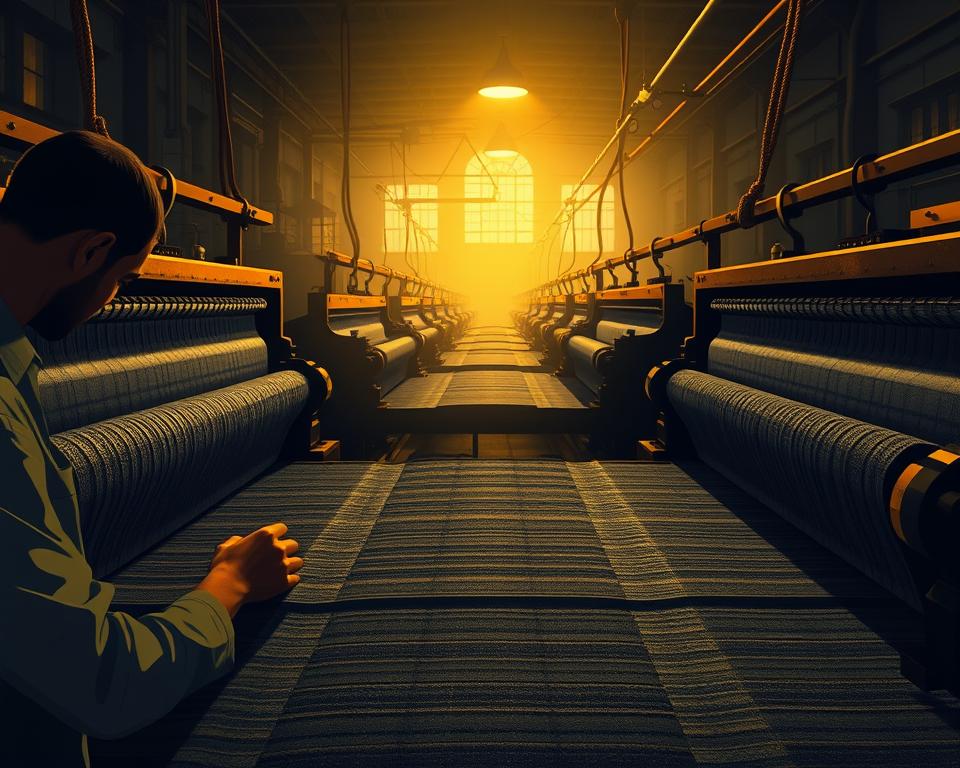Everything You Need to Know About Selvedge Denim Material
A single pair of vintage Levi’s 501s from the 1940s recently sold for $87,400 at auction. Why were these trousers valued higher than a high-end automobile? The answer lies in their selvedge denim material construction.
This high-end denim stands for more than simple material. It connects us to a time when James Dean wore his 501s in Rebel Without a Cause and Marlon Brando defined cool in The Wild One. These cultural icons didn’t just wear jeans. They chose selvedge denim fabric woven on antique shuttle looms.
Handcrafted denim earns its moniker from the self-finished borders that stop fraying. The word “selvedge” fuses “self” and “edge” to depict this singular weaving approach. Differing from factory-made denim, each yard of selvedge denim material requires patience and expertise to craft.
The texture tells a story through subtle irregularities and natural variations. Every pair acquires character as its indigo wears down. This unique aging grants heritage denim its special appeal among collectors and fashion devotees alike.
Many believe premium denim lasts longer than regular jeans. The truth is more nuanced. Selvedge construction creates beautiful fabric with clean edges and rich texture. Yet durability hinges on cotton grade and weight, rather than solely on weaving method. What distinguishes craft denim is its capacity to age elegantly and form distinct faded patterns as time passes.
Understanding Selvedge Denim Material
Selvedge denim fabric is distinct from regular denim due to its unique construction and finished edges. It draws its name from the “self-edge,” a dense woven strip that stops fraying. This top-tier fabric embodies a commitment to slow fashion and classic artisanry, distinguishing it from factory-produced denim.

The Meaning Behind Self-Edge Construction
The word “selvedge” fuses “self” with “edge,” indicating material with a tidy, sealed edge. This narrow selvage runs along both sides, removing the requirement for added finishing. Old-school mills craft it at roughly 30–32 inches wide, unlike contemporary denim’s 60-inch span.
Why Shuttle Looms Yield Distinct Fabric Edges
Shuttle-loomed denim’s character comes from vintage weaving machines that weave at slower speeds. They shuttle one weft yarn across the warp threads in one continuous action. This method results in:
- Organic textural slubs
- A plusher hand-feel versus modern denim
- Tightly bound edges that won’t fray
- Genuine irregularities prized by denim fans
How Selvedge Differs from Standard Denim
Standard denim is made on projectile looms that shoot weft yarns across wider fabric. This method leaves loose threads at the edges, needing overlocked seams to prevent fraying. Selvedge denim fabric, however, requires extra time in production. It offers superior durability and a unique aesthetic, justifying its higher cost.
Heritage and Historical Roots of Shuttle-Loomed Denim
The legacy of heritage denim commenced in U.S. textile mills of the 1800s. Shuttle looms played a vital role, crafting cloth with self-finished edges to stop fraying. This practice created indigo-dyed denim deliberately and meticulously, ensuring every yard was built with attention to detail. The narrow width of this fabric became a hallmark of artisanal denim production.
American Mills of the 1800s to Today’s Resurgence
For over a century, American mills relied on shuttle looms. Brands like Cone Mills and White Oak supplied premium denim to workwear companies. By the 1970s, quick projectile looms dominated, displacing most shuttle machines. This transition was fueled by demand for lower-cost, mass-made denim. Several historic factories wound down or upgraded, causing vintage looms to languish.
How Japan Revived Selvedge Denim
In the 1980s, Japanese producers brought American shuttle looms back into use. The Osaka Five labels headed this resurgence:
- Studio D’Artisan
- Evisu
- Fullcount
- Warehouse
- Denime
These companies merged American vintage style with Japanese precision. They researched antique Levi’s templates, reproducing classic indigo denim textures. By the year 2000, Japan ruled the world’s artisan denim scene.
Relevance of Classic Weaving Now
Shuttle looms yield distinct cloth traits that contemporary machines cannot replicate. This slower method fosters subtle irregularities and fuller indigo soak. Hardcore denim fans treasure these quirks as proof of real craftsmanship.
| Shuttle Loom Features | Modern Loom Features |
|---|---|
| 29-31 inch fabric width | 60+ inch fabric width |
| 3-4 yards per hour | 15-20 yards per hour |
| Natural irregularities | Uniform texture |
| Self-finished edges | Cut edges requiring overlocking |
Crafting Premium Denim with Vintage Looms
The creation of premium denim starts with the rhythmic motion of vintage shuttle looms. These contraptions stand apart from modern machines. They pass yarn across the entire width in one thread, sealing edges without extra finishing. This approach guarantees selvedge denim sports a neat, fray-free border.
Antique looms run slowly, churning out only 5–6 meters of striped denim fabric per day. That stands in bold contrast to contemporary looms weaving 200 meters. Slow operation enhances the yarn by:
- Lower tension in threads produces a plusher hand
- Inherent slubs persist, offering a one-of-a-kind texture
- Uneven surfaces lead to distinctive fading patterns
- Slim widths (around 29–32 inches) cut down waste
Operating these antique machines requires skilled craftsmen. Weavers tweak tension, keep rhythm, and handle fixes. Each shuttle loom carries its own character. Many were built in the 1920s and require know-how passed through the ages. This hands-on approach makes shuttle-loomed denim a true artisan product.
The narrow width of dry denim from vintage looms has a practical benefit. Pant makers utilize the selvedge edge as the outrigger seam, avoiding waste. This highlights the material’s genuine build. Each bolt tells its own tale, boasting faint differences factory lines can’t duplicate.
Raw Denim vs. Selvedge: Key Distinctions
Many denim enthusiasts confuse raw denim with selvedge denim fabric. This misunderstanding crops up while seeking high-end jeans. The fact is they denote separate facets of denim creation. Understanding this difference guides smarter choices and deeper appreciation of each style’s uniqueness.
Why Selvedge Doesn’t Always Mean Raw
Selvedge indicates the shuttle-loom weave that forms self-finished borders. Raw denim stands for unwashed textile direct from production. A selvedge raw denim supplier may stock washed and unwashed varieties. Companies like Naked & Famous craft selvedge jeans, sometimes pre-washed or stretch-infused.
The weaving style is identical. But finishing alters the material’s hand-feel and aesthetic completely.
Washed and Unwashed Denim Compared
All denim starts as dry denim prior to wash. Weavers ship both standard and selvedge bolts unwashed. The main differences are:
- Raw denim evolves custom fade patterns via use
- Pre-washed denim offers instant comfort and stable sizing
- Sanforized raw shrinks little after initial laundering
- Unsanforized denim shrinks notably upon soaking
Debunking Common Denim Misunderstandings
Raw denim isn’t exclusively shuttle-loomed. Today’s projectile looms can also weave unwashed material. The appeal often overlaps because buyers value durability, personalization, and craftsmanship in both selvedge and raw denim. Both varieties entice denim devotees prepared to spend time for ideal custom fading.
Spotting Genuine Selvedge Denim Traits
When you’re in the market for selvadge raw denim fabric wholesaler, being able to spot genuine selvedge denim material is key. It sets you apart from ordinary buyers. Authentic selvedge denim features attributes absent in normal denim. Knowing these signs guarantees you’re buying true high-end denim.
Spotting the Signature Selvedge ID
The clearest way to spot selvedge denim is viewing the outseam. Turn up the cuff and look at the seam along the outside of the leg. Real selvedge denim shows a neat, sealed edge with dyed yarns interwoven. That self-finished border removes the necessity for overlock stitching typical in normal denim.
When you cuff your jeans, the selvedge ID becomes visible, adding a unique touch to your style. The tinted edge threads flow uninterrupted along the outseam, crafting that iconic denim aesthetic fans love. Regular jeans feature raw edges secured with serger stitches to avoid fraying.
Quality Construction Hallmarks
Quality premium denim is evident through several construction details:
- Dense, uniform weaving free of stray threads
- Neat selvedge borders lacking extra seams
- Consistent colored yarn throughout the outseam
- Substantial cloth weight indicative of shuttle-loom output
Rainbow vs Redline Selvedge Distinctions
Rainbow selvedge uses multiple tinted yarns in the ID, crafting a distinct multicolor trim. Redline selvedge, the renowned style, features red edge yarns and originates from heritage American mills. These distinctive selvedge variants fetch more owing to their rarity and visual charm. Most brands proudly highlight these features in product descriptions, making authentic heritage denim easier to identify.
What Drives Artisanal Denim Prices
The cost of artisanal denim often shocks newcomers. Selvedge jeans often cost 3–5× more than factory-made pairs.
Grasping the reasons for these prices uncovers the real worth of high-end denim.
Shuttle looms run far more slowly than contemporary looms. While industrial looms produce fabric quickly, vintage shuttle looms weave only 1-2 meters per hour. That unhurried pace means crafting a bolt of heritage denim spans days, not hours.
The slim selvedge widths increase expenses. Unlike standard denim, which comes in 60-inch widths, premium denim from shuttle looms is just 28-32 inches wide. Such narrowness demands extra planning and precision cutting to optimize usage.
Artisan denim is produced in limited lots. Firms such as Okayama’s White Oak and Kuroki favor excellence over volume. They employ master craftsmen who oversee every step:
- Hand-checking yarn tension
- Adjusting loom settings for each fabric type
- Inspecting every meter for flaws
- Managing rope-dyeing processes that take weeks
These artisans treat denim-making like fine art. They experiment with unique yarns and perfect indigo-dyeing recipes passed down through generations. Buying heritage denim sustains mills upholding textile customs and craftspeople passionate about their trade.
Black Selvedge Denim Fabric Wholesale Options
Premium denim availability now reaches beyond Japan’s heritage mills. American brands now compete, providing a wide range of black selvedge denim fabric wholesale. To find the best supplier, it’s essential to understand quality markers and the origins of authentic materials.
How to Choose Top Suppliers and Mills
Top vendors underscore traditional weaving and genuine devotion to craft. Hunting for a selvedge raw denim wholesaler? Seek out mills still running shuttle looms. These suppliers offer detailed fabric specs, including weight, weave pattern, and dye methods.
Leading Gold Selvedge Denim Mills
Gold-ID selvedge producers spotlight rich edge threads, boosting denim opulence. Leading mills produce these specialty fabrics in limited quantities, attracting boutique brands. The gold thread ID gives these fabrics a unique finish, distinguishing them from standard options.
Sourcing Specialty Fabrics Like Nep Denim
Specialty fabrics like nep denim need specific sourcing channels. This textured fabric features intentional irregularities for unique visual interest. Dealing straight with manufacturers secures supply of these specialty textiles.
| Fabric Type | Minimum Order | Lead Time | Price Range per Yard |
|---|---|---|---|
| Black Selvedge | 500 yards | 6-8 weeks | $12-18 |
| Gold ID Selvedge | 300 yards | 8-10 weeks | $15-22 |
| Nep Denim | 400 yards | 10-12 weeks | $14-20 |
Popular Selvedge Styles and Fabric Variations
Selvedge denim’s realm extends past plain indigo. Today, mills create a wide range of textures and patterns. These showcase the versatility of shuttle loom weaving. Spanning delicate textural shifts to vivid motifs, they present distinct character that matures gracefully with wear.
All About Slub Denim Texture
Slub denim’s distinctive bumpy texture comes from irregular yarns. These yarns have thick and thin spots, creating a fabric surface with natural variations. Woven on shuttle looms, they form slub-textured selvedge that fades unpredictably.
Each slub denim jean yields its own one-off wear pattern. The raised areas wear differently than the smooth sections, making each pair distinct.
Features of Herringbone Selvedge Denim
Herringbone selvedge textile shows a zigzag design similar to fish bones. It yields slanted lines alternating direction at consistent spaces. This motif boosts aesthetics and reinforces the cloth’s durability.
Labels such as Iron Heart and The Strike Gold often employ this weave in their high-end lines.
Understanding Striped Denim & Specialty Weaves
Striped denim fabric incorporates contrasting yarns to create vertical or horizontal lines. Workrooms produce these stripes by alternating colored yarns in the weave. Common variations are:
- Hickory stripe with alternating indigo and white
- Railroad stripe featuring thin pinstripes
- Wabash stripe with printed dots over stripes
| Fabric Type | Visual Pattern | Fade Characteristics |
|---|---|---|
| Slub Denim | Bumpy, irregular surface | High contrast, uneven fading |
| Herringbone | Zigzag diagonal lines | Subtle vertical streaking |
| Striped Denim | Alternating color bands | Pattern remains visible after fading |
Maintaining Your Heritage Denim
Heritage denim needs particular attention to evolve its distinct personality. Unlike regular jeans, raw denim and dry denim transform with wear. They craft individual fade narratives reflecting your life.
Your first few wears in artisan denim might feel firm and odd. This experience is expected. It takes time for the cloth to soften and contour your form. Some denim enthusiasts speed up this process by wearing their jeans in the shower or doing squats while damp. Others prefer a slower, more natural break-in period.
Raw denim develops its best fades when you wait to wash it. The oils from your skin and friction from daily wear create whiskers behind the knees and honeycombs at the back. Many wearers wait six months for the first wash, and some even a year. This discipline grants you dramatic, bespoke fades reflecting your motions.
When it’s time to wash your dry denim, turn it inside out and use cold water. Forego spin and drip-dry in shade. Some choose hand-washing in a tub with mild soap. Refrain from hot washes and dryers to prevent shrinkage and loss of fades.
Your denim investment appreciates with correct maintenance. Each use builds character, turning your jeans into a singular piece. The rigid start transforms into a comfortable second skin that reflects your lifestyle and movement patterns.
Where to Find Quality Indigo-Dyed Denim
The resurgence of selvedge denim has opened up new avenues for denim enthusiasts. Large chains now offer indigo denim, while niche shops continue premium slow-fashion offerings. This allows consumers to find authentic selvedge options at various price points, catering to different budgets and styles.
Levi’s offers their 501 Original Fit Selvedge Jeans for $148, making heritage craftsmanship accessible to a wider audience. Uniqlo offers its Selvedge Straight at $50, striking a balance between style and price. If you want luxury, Buck Mason stocks Japanese Loom State Selvedge Full-Saddle Jeans for $248. Iron Heart takes premium denim to the next level with their 634s-18 Vintage Denim Jeans, priced at $385, available through Self Edge stores.
American names like Todd Snyder and Buck Mason have entered competition with Japanese maestros in the selvedge scene. They realize that classic weaving methods and excellence underpin slow-fashion success. Whether you shop digitally or in-store, quality indigo denim is now more reachable for U.S. buyers who value true craftsmanship.


